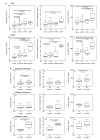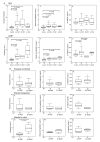In vivo effects of HIV-1 exposure in the presence and absence of single-dose nevirapine on cellular plasma activation markers of infants born to HIV-1-seropositive mothers
- PMID: 16837862
- PMCID: PMC2367220
- DOI: 10.1097/01.qai.0000225009.30698.ce
In vivo effects of HIV-1 exposure in the presence and absence of single-dose nevirapine on cellular plasma activation markers of infants born to HIV-1-seropositive mothers
Abstract
Short-course antiretroviral drug regimens reduce the risk of mother-to-child transmission of HIV-1, but mechanisms affording protection of such interventions remain poorly defined. Because T-cell activation is an important factor in productive HIV-1 infection, we tested the hypothesis that single-dose nevirapine (NVP) reduces immune activation, which in turn reduces the likelihood of transmission. We compared concentrations of cord and maternal blood plasma immune activation markers, neopterin, beta2-microglobulin, and soluble l-selectin, in 2 groups of HIV-1-exposed newborns whose mothers either received NVP at the onset of labor or who only received NVP as postexposure prophylaxis within 72 hours of birth and among HIV-unexposed controls. In utero exposure of the infant to HIV-1, regardless of NVP exposure, led to demonstrable increases in immune activation markers, this being most notable in the presence of preexisting infection. Contrary to what was hypothesized, immune activation was increased by prebirth exposure to single-dose NVP, with this effect being enhanced in infants already infected at birth. Our data suggest that reductions in immune activation do not explain transmission prevention effects of single-dose NVP. Our data also suggest a biological explanation for why HIV-1-infected infants exposed perinatally to antiretroviral drugs might experience hastened disease progression, namely, in some HIV-1-infected individuals, NVP may synergize with HIV-1 to enhance an environment that favors increased HIV-1 replication.
Figures


Similar articles
-
Nevirapine and zidovudine at birth to reduce perinatal transmission of HIV in an African setting: a randomized controlled trial.JAMA. 2004 Jul 14;292(2):202-9. doi: 10.1001/jama.292.2.202. JAMA. 2004. PMID: 15249569 Clinical Trial.
-
Maternal 12-month response to antiretroviral therapy following prevention of mother-to-child transmission of HIV type 1, Ivory Coast, 2003-2006.Clin Infect Dis. 2008 Feb 15;46(4):611-21. doi: 10.1086/526780. Clin Infect Dis. 2008. PMID: 18197758
-
Slower clearance of nevirapine resistant virus in infants failing extended nevirapine prophylaxis for prevention of mother-to-child HIV transmission.AIDS Res Hum Retroviruses. 2011 Aug;27(8):823-9. doi: 10.1089/aid.2010.0346. Epub 2011 Feb 25. AIDS Res Hum Retroviruses. 2011. PMID: 21241214 Free PMC article. Clinical Trial.
-
Nevirapine resistance after single dose prophylaxis.AIDS Rev. 2002 Apr-Jun;4(2):59-63. AIDS Rev. 2002. PMID: 12152519 Review.
-
Antiretroviral therapy for prevention of mother-to-child HIV transmission : focus on single-dose nevirapine.Clin Drug Investig. 2006;26(11):611-27. doi: 10.2165/00044011-200626110-00001. Clin Drug Investig. 2006. PMID: 17163296 Review.
Cited by
-
Growth Trajectories of HIV Exposed and HIV Unexposed Infants. A Prospective Study in Gweru, Zimbabwe.Glob Pediatr Health. 2021 Feb 4;8:2333794X21990338. doi: 10.1177/2333794X21990338. eCollection 2021. Glob Pediatr Health. 2021. PMID: 33614842 Free PMC article.
-
Transfer of Maternal Antimicrobial Immunity to HIV-Exposed Uninfected Newborns.Front Immunol. 2016 Aug 31;7:338. doi: 10.3389/fimmu.2016.00338. eCollection 2016. Front Immunol. 2016. PMID: 27630640 Free PMC article. Review.
-
Naturally-occurring genetic variants in human DC-SIGN increase HIV-1 capture, cell-transfer and risk of mother-to-child transmission.PLoS One. 2012;7(7):e40706. doi: 10.1371/journal.pone.0040706. Epub 2012 Jul 10. PLoS One. 2012. PMID: 22808239 Free PMC article.
-
African infants' CCL3 gene copies influence perinatal HIV transmission in the absence of maternal nevirapine.AIDS. 2007 Aug 20;21(13):1753-61. doi: 10.1097/QAD.0b013e3282ba553a. AIDS. 2007. PMID: 17690574 Free PMC article.
-
Reduced B cell frequencies in cord blood of HIV-exposed uninfected infants: an immunological and transcriptomic analysis.Front Immunol. 2024 Sep 4;15:1445239. doi: 10.3389/fimmu.2024.1445239. eCollection 2024. Front Immunol. 2024. PMID: 39295873 Free PMC article.
References
-
- Connor EM, Sperling RS, Gelber R, et al. Reduction of maternal-infant transmission of human immunodeficiency virus type 1 with zidovudine treatment. Pediatric AIDS Clinical Trials Group Protocol 076 Study Group. N Engl J Med. 1994;331(18):1173–1180. - PubMed
-
- Guay LA, Musoke P, Fleming T, et al. Intrapartum and neonatal single-dose nevirapine compared with zidovudine for prevention of mother-to-child transmission of HIV-1 in Kampala, Uganda: HIVNET 012 randomised trial. Lancet. 1999;354(9181):795–802. - PubMed
-
- Shaffer N, Chuachoowong R, Mock PA, et al. Short-course zidovudine for perinatal HIV-1 transmission in Bangkok, Thailand: a randomised controlled trial. Bangkok Collaborative Perinatal HIV Transmission Study Group. Lancet. 1999;353(9155):773–780. - PubMed
-
- Wiktor SZ, Ekpini E, Karon JM, et al. Short-course oral zidovudine for prevention of mother-to-child transmission of HIV-1 in Abidjan, Cote d’Ivoire: a randomised trial. Lancet. 1999;353(9155):781–785. - PubMed
-
- Dabis F, Msellati P, Meda N, et al. 6-Month efficacy, tolerance, and acceptability of a short regimen of oral zidovudine to reduce vertical transmission of HIV in breastfed children in Cote d’Ivoire and Burkina Faso: a double-blind placebo-controlled multicentre trial. DITRAME Study Group. DIminution de la Transmission Mere-Enfant. Lancet. 1999;353(9155):786–792. - PubMed
Publication types
MeSH terms
Substances
Grants and funding
LinkOut - more resources
Full Text Sources
Medical

